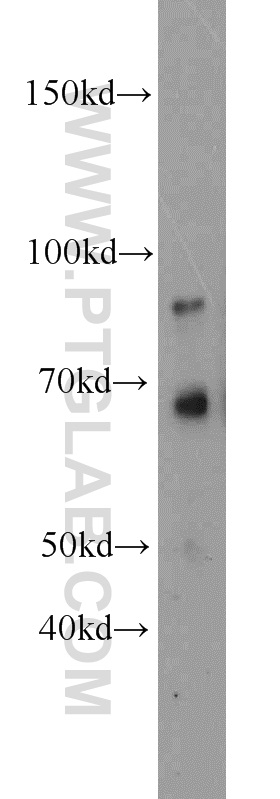验证数据展示
经过测试的应用
| Positive WB detected in | mouse liver tissue |
推荐稀释比
| 应用 | 推荐稀释比 |
|---|---|
| Western Blot (WB) | WB : 1:200-1:1000 |
| It is recommended that this reagent should be titrated in each testing system to obtain optimal results. | |
| Sample-dependent, Check data in validation data gallery. | |
发表文章中的应用
| IF | See 3 publications below |
产品信息
10890-1-AP targets KIRREL2 in WB, IF, ELISA applications and shows reactivity with human, mouse, rat samples.
| 经测试应用 | WB, ELISA Application Description |
| 文献引用应用 | IF |
| 经测试反应性 | human, mouse, rat |
| 文献引用反应性 | human |
| 免疫原 |
CatNo: Ag1036 Product name: Recombinant human KIRREL2 protein Source: e coli.-derived, PGEX-4T Tag: GST Domain: 1-219 aa of BC007312 Sequence: MLRMRVPALLVLLFCFRGRAGPSPHFLQQPEDLVVLLGEGGAQASLGRRASASFSEQKNLMRIPGSSDGSSSRGPEEEETGSREDRGPIVHTDHSDLVLEEEGTLETKDPTNGYYKVRGVSVSLSLGEAPGGGLFLPPPSPLGPPGTPTFYDFNPHLGMVPPCRLYRARAGYLTTPHPRAFTSYIKPTSFGPPDLAPGTPPFPYAAFPTPSHPRLQTHV 种属同源性预测 |
| 宿主/亚型 | Rabbit / IgG |
| 抗体类别 | Polyclonal |
| 产品类型 | Antibody |
| 全称 | kin of IRRE like 2 (Drosophila) |
| 别名 | Kin of irregular chiasm-like protein 2, Kin of IRRE-like protein 2, NEPH3, Nephrin-like protein 3, UNQ5827/PRO19646 |
| 计算分子量 | 75 kDa |
| 观测分子量 | 67 kDa, 90 kDa |
| GenBank蛋白编号 | BC007312 |
| 基因名称 | KIRREL2 |
| Gene ID (NCBI) | 84063 |
| RRID | AB_2130842 |
| 偶联类型 | Unconjugated |
| 形式 | Liquid |
| 纯化方式 | Antigen affinity purification |
| UNIPROT ID | Q6UWL6 |
| 储存缓冲液 | PBS with 0.02% sodium azide and 50% glycerol, pH 7.3. |
| 储存条件 | Store at -20°C. Stable for one year after shipment. Aliquoting is unnecessary for -20oC storage. |
实验方案
| Product Specific Protocols | |
|---|---|
| WB protocol for KIRREL2 antibody 10890-1-AP | Download protocol |
| Standard Protocols | |
|---|---|
| Click here to view our Standard Protocols |
发表文章
| Species | Application | Title |
|---|---|---|
Nat Protoc Generation and long-term culture of human cerebellar organoids from pluripotent stem cells | ||
Life Med CRISPR/Cas9-mediated genetic correction reverses spinocerebellar ataxia 3 disease-associated phenotypes in differentiated cerebellar neurons |

